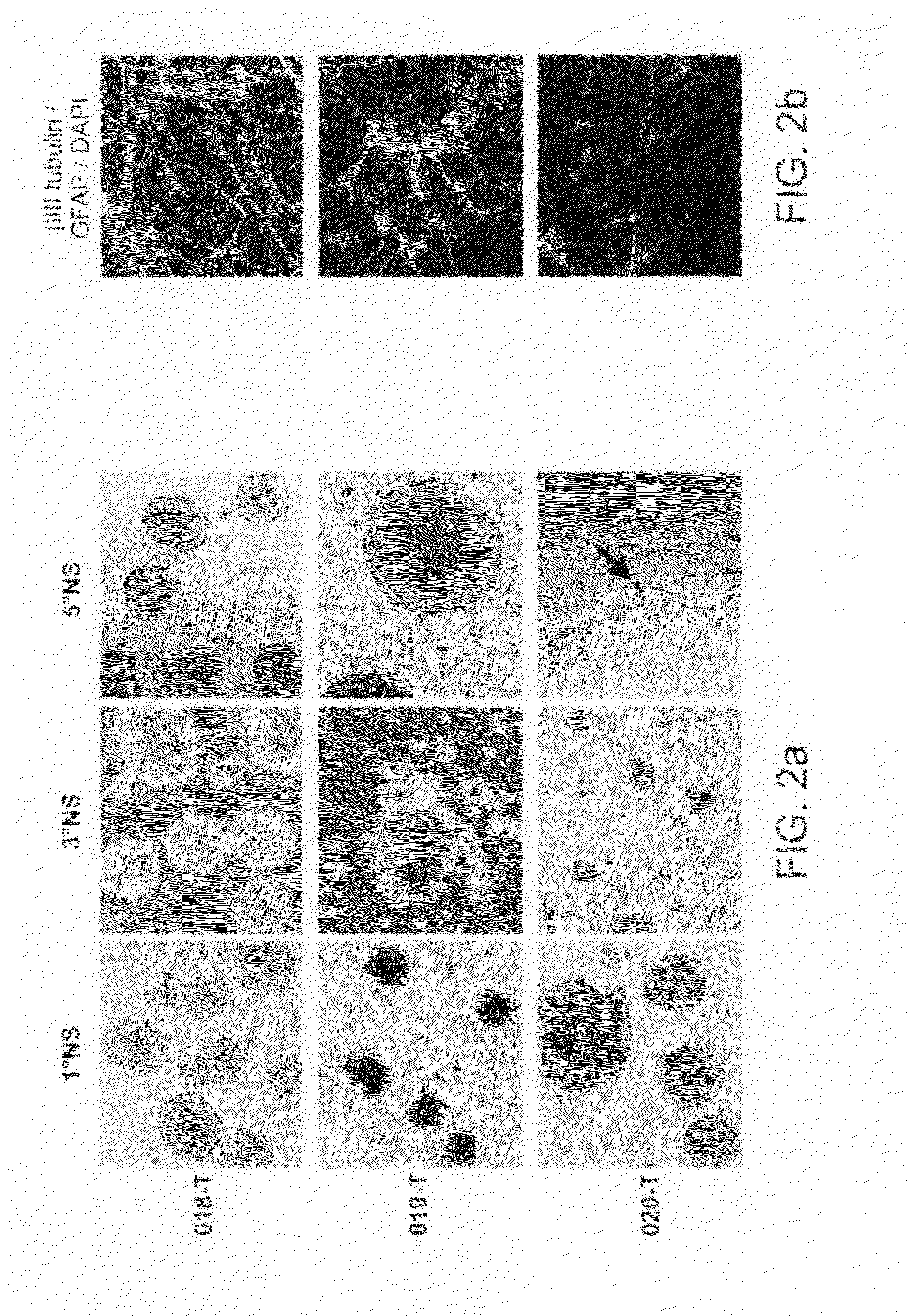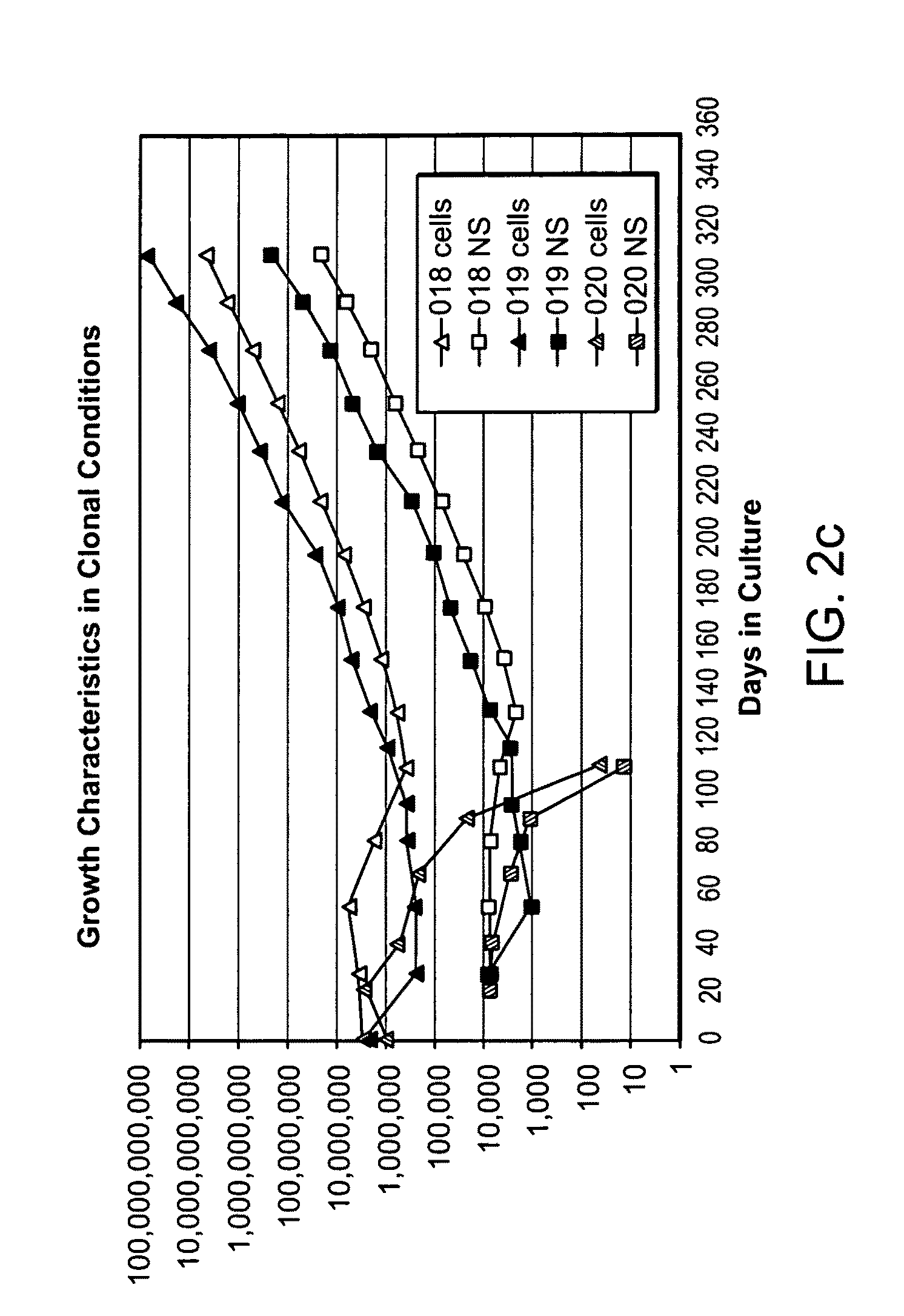Isolation, expansion and uses of tumor stem cells
a tumor stem cell and cell technology, applied in the field of cell compositions and methods of production, can solve the problems of preventing and affecting the development of effective therapies
- Summary
- Abstract
- Description
- Claims
- Application Information
AI Technical Summary
Benefits of technology
Problems solved by technology
Method used
Image
Examples
example 1
Materials and Methods
[0079]The following materials and methods are generally useful to carry out the invention, and were used as needed to conduct studies outlined in the Examples.
[0080]Derivation of Cells and Methods of Culturing.
[0081]Human tissue derived from brain surgery was transferred to the laboratory following institutional approved protocols. Brain tissue was minced under sterile conditions into chunks of about 5 mm3 (illustrated in FIG. 1A), and randomly divided into two equal parts. One part was fixed in 4% paraformaldehyde and stored until further use for histological analysis; the other part was further minced to 1 mm3-sized chunks of vital tissue, which was used for in vitro preparations.
[0082]The steps in preparation of standard neurosphere (NS) cultures (assays) is shown schematically in FIG. 1B. Vital brain tissue as described above was placed in a 0.25% trypsin solution on a shaker overnight at 4° C. Five percent fetal calf serum (FCS, HyClone) was added, and the ...
example 2
Preparation of Cell Lines from Human Pediatric Brain Tumors Using Standard Neurosphere Assay Conditions
[0100]In an initial study, tissue samples were randomly collected from pediatric brain tumors over the course of one year. The tumors were located in a broad range of CNS locations, and histopathological diagnosis ranged from WHO scale II (slow growing tumor) through IV (highly malignant, fast growing). Five additional samples that served as a control group for this study were either diagnosed as not of tumor origin, or represented tumors not primarily originating from CNS tissue (Table 1, infra).
TABLE 1Description of cases and tissue samples used for analysis.CaseAge / SexLocationPathologic Diagnosis001 6 / F4th ventricle, cerebellar-pontine angleEpendymoma w / “classic” histology.00210 mt / FSuprasellar, w / optic apparatus involvedPilomyxoid astrocytoma. Uniform, piloid-microcystic.003 3 / F4th ventricle / posterior fossaPNET / medulloblastoma w / “classic” histology.004 6 / FSuperior vermis / pineal...
example 3
Clonal Cancer Stem Cell Lines Derived from Human Pediatric Brain Tumors
[0105]The standard NS assay, although suitable for identifying tissue samples comprising self-renewing stem cells as shown in the above Example, is limited in its usefulness for purposes of purification, expansion, and detailed study of putative stem cell populations by numerous factors including the slow increase of total cell numbers and low ratios of NSFC to other non-tumorigenic cells; the lengthy passage time (2-3 weeks); and the uncontrollable environment that exists within neurospheres. This study was undertaken to evaluate surface coatings for cell culture dishes that could be useful for isolating, maintaining and expanding human brain tumor-derived cancer stem cells under controlled conditions.
[0106]A total of eight different cell populations was separated, based on their migratory competence and preference to attach to distinct substrates at the time of tissue extraction, using procedures as described a...
PUM
| Property | Measurement | Unit |
|---|---|---|
| time | aaaaa | aaaaa |
| concentration | aaaaa | aaaaa |
| concentration | aaaaa | aaaaa |
Abstract
Description
Claims
Application Information
 Login to View More
Login to View More - R&D
- Intellectual Property
- Life Sciences
- Materials
- Tech Scout
- Unparalleled Data Quality
- Higher Quality Content
- 60% Fewer Hallucinations
Browse by: Latest US Patents, China's latest patents, Technical Efficacy Thesaurus, Application Domain, Technology Topic, Popular Technical Reports.
© 2025 PatSnap. All rights reserved.Legal|Privacy policy|Modern Slavery Act Transparency Statement|Sitemap|About US| Contact US: help@patsnap.com



